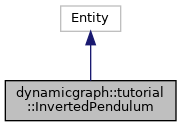Inverted Pendulum on a cart. More...
#include <dynamic-graph/tutorial/inverted-pendulum.hh>


Public Member Functions | |
| InvertedPendulum (const std::string &inName) | |
| Constructor by name. More... | |
| ~InvertedPendulum () | |
| virtual const std::string & | getClassName (void) const |
| Each entity should provide the name of the class it belongs to. More... | |
| virtual std::string | getDocString () const |
| Header documentation of the python class. More... | |
| void | incr (double inTimeStep) |
| Integrate equation of motion over time step given as input. More... | |
Parameters | |
| void | setCartMass (const double &inMass) |
| Set the mass of the cart. More... | |
| double | getCartMass () const |
| Get the mass of the cart. More... | |
| void | setPendulumMass (const double &inMass) |
| Set the mass of the cart. More... | |
| double | getPendulumMass () const |
| Get the mass of the pendulum. More... | |
| void | setPendulumLength (const double &inLength) |
| Set the length of the cart. More... | |
| double | getPendulumLength () const |
| Get the length of the pendulum. More... | |
Static Public Attributes | |
| static const std::string | CLASS_NAME |
Detailed Description
Inverted Pendulum on a cart.
This class represents the classical inverted pendulum on a cart. The equation of motion is:
\begin{eqnarray*} \left ( M + m \right ) \ddot x - m l \ddot \theta \cos \theta + m l \dot \theta^2 \sin \theta &=& F\\ m l (-g \sin \theta - \ddot x \cos \theta + l \ddot \theta) &=& 0 \end{eqnarray*}
where
- the state is a vector of dimension 4 \((x,\theta,\dot{x},\dot{\theta})\) represented by signal stateSOUT,
- \(x\) is the position of the cart on an horizontal axis, \(\theta\) is the angle of the pendulum with respect to the vertical axis,
- the input is a vector of dimension 1 \((F)\) reprensented by signal forceSIN,
- m, M and l are respectively the mass of the pendulum, the mass of the cart and the length of the pendulum.
A more natural form of the above equation for roboticists is
\[ \textbf{M}(\textbf{q})\ddot{\textbf{q}} + \textbf{N}(\textbf{q},\dot{\textbf{q}})\dot{\textbf{q}} + \textbf{G}(\textbf{q}) = \textbf{F} \]
where
\begin{eqnarray*} \textbf{q} &=& (x, \theta) \\ \textbf{M}(\textbf{q}) &=& \left( \begin{array}{cc} M + m & -m\ l\ \cos\theta \\ -m\ l\ \cos\theta & m\ l^2 \end{array}\right) \\ \textbf{N}(\textbf{q},\dot{\textbf{q}}) &=& \left( \begin{array}{cc} 0 & m\ l\ \dot{\theta} \sin\theta \\ 0 & 0 \end{array}\right)\\ \textbf{G}(\textbf{q}) &=& \left( \begin{array}{c} 0 \\ -m\ l\ g\ \sin\theta \end{array}\right)\\ \textbf{F} &=& \left( \begin{array}{c} F \\ 0 \end{array}\right) \end{eqnarray*}
In order to make the system intrinsically stable, we add some viscosity by rewriting:
\begin{eqnarray*} \textbf{N}(\textbf{q},\dot{\textbf{q}}) &=& \left( \begin{array}{cc} \lambda & m\ l\ \dot{\theta} \sin\theta\\ 0 & \lambda \end{array}\right) \end{eqnarray*}
where \(\lambda\) is a positive coefficient.
Constructor & Destructor Documentation
◆ InvertedPendulum()
| dynamicgraph::tutorial::InvertedPendulum::InvertedPendulum | ( | const std::string & | inName | ) |
Constructor by name.
◆ ~InvertedPendulum()
| dynamicgraph::tutorial::InvertedPendulum::~InvertedPendulum | ( | ) |
Member Function Documentation
◆ getCartMass()
|
inline |
Get the mass of the cart.
◆ getClassName()
|
inlinevirtual |
Each entity should provide the name of the class it belongs to.
◆ getDocString()
|
inlinevirtual |
Header documentation of the python class.
◆ getPendulumLength()
|
inline |
Get the length of the pendulum.
◆ getPendulumMass()
|
inline |
Get the mass of the pendulum.
◆ incr()
| void dynamicgraph::tutorial::InvertedPendulum::incr | ( | double | inTimeStep | ) |
Integrate equation of motion over time step given as input.
◆ setCartMass()
|
inline |
Set the mass of the cart.
◆ setPendulumLength()
|
inline |
Set the length of the cart.
◆ setPendulumMass()
|
inline |
Set the mass of the cart.
Member Data Documentation
◆ CLASS_NAME
|
static |
The documentation for this class was generated from the following file:
- include/dynamic-graph/tutorial/inverted-pendulum.hh
